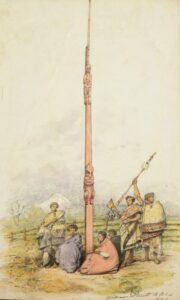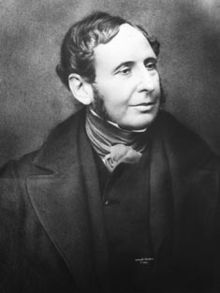1844: FitzRoy’s Pole
December 26, 2022
By AHNZ
 The Taranaki War in the 1860s over control of land has its roots in conflict long before Western Settlers came to New Zealand. Maori tribes had been treating each other to cruelty back into antiquity over the territory around Mt Egmont. After the Maoris became British citizens in 1840 their historical conflicts and feuds became headaches for the newly established Crown Colony of New Zealand (1841) to deal with.
The Taranaki War in the 1860s over control of land has its roots in conflict long before Western Settlers came to New Zealand. Maori tribes had been treating each other to cruelty back into antiquity over the territory around Mt Egmont. After the Maoris became British citizens in 1840 their historical conflicts and feuds became headaches for the newly established Crown Colony of New Zealand (1841) to deal with.
One such iteration of the conflict was the Siege of Pukerangiora Pa in December 1831. After 3 months the Te Atiawa pa fell to the genocidal Waikato invaders. The leader of the invasion force, Te Wherowhero, future Maori King, next besieged Otaka but thanks to an alliance between Te Wharepouri and Richard ‘Dicky’ Barrett it failed. Just the same, the survivors had to become refugees and depart. Ref. 1832: Siege of Otaka, AHNZ
The Waikato tribe, by right of conquest, now ‘owned’ this depopulated territory and it was they who expected to be paid by anyone who wished to re-inhabit Taranaki. Governor William Hobson had to deal with and pay off the bloodthirsty Te Wherowhero. And, he did. The Colony opened the land up again and some of the Taranaki Maoris were able to go home and, in turn, desired to sell to Western Settlers some of the land they had regained.
By the 1840s the repatriated Te Atiawa were feeling secure enough to insist on some rules. One of these stakeholders, Chief Te Waitere Katatore, wanted to set a clear limit on what land would and would not be sold. Land Claims Commissioner William Spain was part of Governor Hobson’s Government and this administration set the rules in May 1844 on dividing up Taranaki. Some land would be for Settlers such as the Barrett family, some for the natives, some for the Wesleyan Mission.
Men like Katatore were far from satisfied with the Hobson Administration’s decision so he must have been delighted in late 1844 when the new Governor Robert FitzRoy scrapped Spain’s ruling during his own visit to Taranaki. FitzRoy pulled back the Settlers into the ‘FitzRoy Block’ which included New Plymouth Town. Katatore, gleefully, planted a great marker post 9m tall to signpost the point beyond which no Western Settlers could buy Taranaki lands.
 This post was known as FitzRoys’ Pole or, to the Maoris, the Po-tutaki Pole. Unfortunately there are no photos although it endured to the 1870s. Katatore set two life-sized figures of men on the post which the William Strutt image (left) does not do justice to. A triumphant Maori warrior was up top with his arms raised to the sun as if striking down the “pakeha” under his feet. The Western Settler below was carved to look dejected and forlorn. Katatore was rubbing salt into the wounds of all the families who FitzRoy had commanded to give up their settlements and start again on the other side of the pole.
This post was known as FitzRoys’ Pole or, to the Maoris, the Po-tutaki Pole. Unfortunately there are no photos although it endured to the 1870s. Katatore set two life-sized figures of men on the post which the William Strutt image (left) does not do justice to. A triumphant Maori warrior was up top with his arms raised to the sun as if striking down the “pakeha” under his feet. The Western Settler below was carved to look dejected and forlorn. Katatore was rubbing salt into the wounds of all the families who FitzRoy had commanded to give up their settlements and start again on the other side of the pole.
What we do have is a sketch by William Strutt (or William Street?) However, in the 1920s, the Alexander Turnbull Library gave New Plymouth Library a better version of the picture showing the pole from 3 angles. Katatore’s pole fell over in the 1870s after a brush fire and then a government employee with no respect for history hacked it up for firewood! Chief Katatore himself was slain (1854, 1857, or 1858 depending on source) in a revenge killing of the Te Ati Awa Fued. FitzRoy’s Administration had made a mess of things.
“…the old settlers’ room, at the New Plymouth Library has received…picture is of the celebrated Fitzroy pole, which was erected by the Natives in 1845 approximately about the junction of the Devon Line and Smart Road, and which was to mark the extreme boundary to which the pakehas were to be allowed to purchase land. This sketch gives the full details of the figure from three points of view, the main picture depicting a group of natives in their costume o those days around the pole….” – Patea Mail (1921,) Papers Past
“This pole, which bore carvings symbolical of the (supposed) superiority of the Maori over the Pakeha had been erected by the natives in 1844 to mark the northern boundary of the region in which the white men were to he allowed to settle. Settlement had extended much beyond it, but the Governor (Capt. R. Fitzroy, R.N.) had held that the purchase of the land had not been valid and the settlers had been ejected. A fire in the fern or other growth covering the surrounding ground felled the pole and the toil keeper with a distressing lack of appreciation of its historic value, cut it up for firewood.” – Ashburton Guardian, (1925,) Papers Past
“An historic landmark which existed in the Fitzroy district until some time in the mid-seventies, when it was destroyed by fire, is remembered by the older residents of the district. It was known as the Fitzroy pole and had .it been preserved would have, stood as an extremely interesting relic of the unsettled days when pakeha and Maori differed. Known by the Maoris as the Po-tutaki pole, it stood for many years near the junction of the present Devon Line and Smart Road. This great shaft of puriri was erected by the Puketapu natives in derision of Mr. Commissioner Spain’s award which legalised the purchase by the New Zealand. Company of the land extending to and beyond Waitara.”
“The pole had two life size, figures carved on it, the one below depicting the pakeha in a most dejected and forlorn attitude, the one above representing the Maori triumphant, making a fearful grimace. and with arms erect in the attitude of striking, down the pakeha. Beyond the pole the Maoris of that day said no foot of land should be sold or occupied by Europeans. That held good up to the Waitara war and all the trouble that followed.”
“Unfortunately through an accident a gorse fire burnt the bane of the pole and it fell. It, was eventually chopped up for firewood by the old toll-gate keeper when the gate stood at the junction of Smart Road and Devon Line. The base of the pole is believed to be still, in the ground where the pole stood but it has not been searched for. If located it-will be another valuable link with Taranaki’s past.” – Taranaki Daily News (1932,) Papers Past
It was Katatore; a little, cunning-looking, ill-favored rascal as I ever saw, dressed in a black patetot, moleskin trousers, boots, and a little hat on the top of an immense bush of hair. He then told us the story of the murder. When he came to it, the Bishop said, “So, then, you killed an unarmed man in cold blood for the matter of land?” “Yes.”… his mop of black hair stood up a foot above his head; and as he spoke to the Bishop, calmly or energetically as the subject suited, he evidently swayed his people to and fro with the talent of a real orator.” – Missions to the Heathen, Abraham (1855,) Anglicanhistory.org
 Robert FitzRoy’s Governorship (26 December 1843 – 18 November 1845) over the Crown Colony of New Zealand was out of step with natives and Settlers fixed in K-selected cultures. We were Honour Culture then Dignity Culture but FitzRoy tried to govern New Zealand with Victimhood Culture. He was appeasing toward Maori aggression which made him look weak and egged on the likes of Katatore Wiremu Kingi and to act like childish mutilated baby-men. “I will not give it up! I will not! I will not!” said Kingi about the land as if having a massive tantrum. Sometimes people get promoted and promoted up to the point where they become incompetent at higher role they have been appointed to¹. FitzRoy was better off being the captain of a scientific expedition but even then he required the company of Charles Darwin to help keep him sane in the rough and raw frontier. Ref. 1835: The Voyage of the Beagle, AHNZ
Robert FitzRoy’s Governorship (26 December 1843 – 18 November 1845) over the Crown Colony of New Zealand was out of step with natives and Settlers fixed in K-selected cultures. We were Honour Culture then Dignity Culture but FitzRoy tried to govern New Zealand with Victimhood Culture. He was appeasing toward Maori aggression which made him look weak and egged on the likes of Katatore Wiremu Kingi and to act like childish mutilated baby-men. “I will not give it up! I will not! I will not!” said Kingi about the land as if having a massive tantrum. Sometimes people get promoted and promoted up to the point where they become incompetent at higher role they have been appointed to¹. FitzRoy was better off being the captain of a scientific expedition but even then he required the company of Charles Darwin to help keep him sane in the rough and raw frontier. Ref. 1835: The Voyage of the Beagle, AHNZ
FitzRoy found a better comfort zone working as a meteorologist rather than trying to solve conflicts in the navy or in New Zealand. Even so, that more pedestrian role wasn’t enough to keep back depression and, in the end, suicide. Ref. 1865: New Zealand Governor Commits Suicide, AHNZ
FitzRoy was more in step with the r-selected broom sweeping Europe which culminated in the The Year of Revolutions (1848.) “The Revolutions of 1848,…were a series of political upheavals throughout Europe starting in 1848. It remains the most widespread revolutionary wave in European history to date. The revolutions were essentially democratic and liberal in nature, with the aim of removing the old monarchical structures and creating independent nation-states, as envisioned by romantic nationalism.”
FitzRoy was far before his time in trying to govern this way in New Zealand. It wasn’t time for playing Dad to the fabled ‘noble savage’. Here on the New Zealand frontier we were still fighting pistol duels, forming militias, playing cowboy cops and getting massacred. Radical ideas such as Britain’s People’s Charter (1838) and like political reforms apparently were swimming in FitzRoy’s head. The same Colonial Office backing this Woke policy probably also put Robert’s elder half-brother in charge as Governor of New South Wales. Charles Augustus FitzRoy was supposed to be a softer alternative to what NSW had before too². The Church Missionary Society backed FitzRoy as the Big Softy they thought the natives needed³. The idea that these Romantic gentle Governors would preside over a Trans-Tasman dynasty hit the hard reality of New Zealand’s raw patchwork⁴. Ref. Lepidoptera Zealandia, AHNZ
The Taranaki Settlers were angry with FitzRoy’s Big Softy appeasement approach to their feuding Maori neighbors. He had done the same thing with Te Rauparaha’s Ngati Toa who had actually retreated in anticipation of the British Empire striking violently back after The Wairau Massacre. The Cook Straight Settlers were shocked and infuriated by FitzRoy’s appeasing push-over policy. The Empire, under FitzRoy, did not strike back! 1843: The Empire Strikes Back?, AHNZ
 FitzRoy’s policies, he admitted, had been a great failure. His reputation in tatters and New Zealand basically on fire, as punctuated by the Sacking of Russell in March 1845, FitzRoy was recalled by the British Colonial Secretary. Ref. 1845: The Sacking of Russell, AHNZ
FitzRoy’s policies, he admitted, had been a great failure. His reputation in tatters and New Zealand basically on fire, as punctuated by the Sacking of Russell in March 1845, FitzRoy was recalled by the British Colonial Secretary. Ref. 1845: The Sacking of Russell, AHNZ
The Crown Colonies 3rd Administration was a much better fit for the people it had to wrangle. Grey Dignity Culture Era is named for Governor George Grey who presided over it. Grey was a very marked contrast to his predecessor. He rampaged over New Zealand distributing law and order with great cunning and generalship where he could but was quite happy to settle for order and ditch the law part. Grey got started on 18 November 1845. It wasn’t long after that he unleashed armed policemen on the population, kidnapped Rauparaha, and made the natives docile with free flour and sugar!
New Zealand was now being governed for the first time by a man with the right temperament for the times. There was no ‘Grey’s Pole’ in Taranaki or anywhere else. If there had been then George would have had the author remove it at their own cost and shame rather than stand mocking him and his people for 25 years as FitzRoy’s Pole did.
—
1 Ref. The Peter Principle, Nevit Dilmen, Wiki
2. “It is likely that FitzRoy was chosen because he tended to be more appeasing in his approach.” – Charles Augustus FitzRoy, Wiki
3. The CMS preference for a man like FitzRoy seems like a big change from the organisation that had only a year and a half before sent out George Selwyn to be Bishop of New Zealand. This was an energetic Conservative operator who whipped his Missionaries into shape to the advantage of the new Crown Colony Government. The Missionaries must have complained. Apparently the CMS had a regime change and deployed FitzRoy as an antidote. Ref. 1842: The Bishop of New Zealand, AHNZ
4. Deeper mystery here as to why Lord Stanley, Secretary of State for War and the Colonies, in the Peel 2.0 Ministry set the FitzRoy brothers up to rule Down Under. This was a Conservative not a Lefty Liberal Whig Ministry. Prime Minister Robert Peel, Free Trader Corn Law Abolitionist, like Robert FitzRoy himself, wasn’t Conservative enough for Lord Stanley who was a Conservative’s Conservative. Why would Stanley deploy the FitzRoys when they don’t seem to be cut from the cloth he likes at all? Can only suppose it was a political trade-off so he could get something else he wanted at Home and that what happened in Australia and New Zealand was not a priority in the 1840s. Perhaps Stanley wanted FitzRoy fail, even at New Zealand’s expense, so he could recall him, which he did, to embarrass his Whiggy Wokester opposition?
Image ref. FitzRoy’s Pole, William Strutt (or Street,) Alexander Turnbull Library
Image ref. The Peter Principle, Nevit Dilmen, Wiki
2 thoughts on "1844: FitzRoy’s Pole"
Leave a Reply
 Like Comment Share
Like Comment Share






This is an excellent snapshot of those times. The Waitara block had to be purchased from so many different entities that it is bewildering.
Why Waikato got involved in the first Taranaki War after having sold the land involved in that dispute highlights the no win situation of the settlers. Pretty much the same situation we have today, ha!
Thanks for that. Simply found a picture of the Pole and that took me down a couple of rabbit holes. Keeping this history where modern New Zealanders can see it.